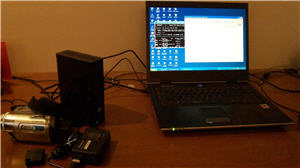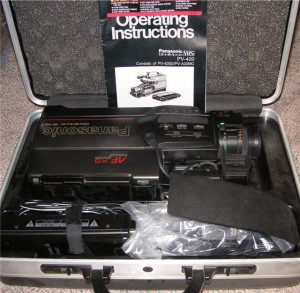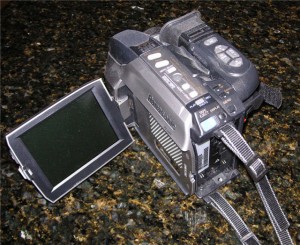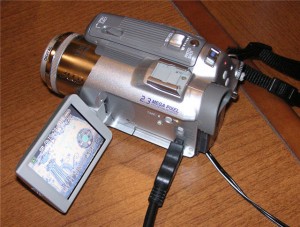Capture Home Video While You Still Can

Some may wonder why I have done a review of the Seagate FreeAgent GoFlex external hard drive and several videos on its use recently.
Well, it’s because of what’s going on in my personal life.
My kids are now pretty much grown and starting to go their own way. They certainly don’t think much of mom or dad grabbing the video camera to get footage of them doing things.
And with our recent move, one sorts the important from the unimportant, being very careful to preserve and keep track of the important.
For us, much like the in the movie Richie Rich, our treasure is our children and the memories of them growing up. Many of those memories are digital.
The advantage to digital memories is that they can be backed up. And since I am a backup freak having a single copy of a VHS video tape from days of old or a newer miniDV tape is certainly not enough.
But in my mind, it’s a backup that does NOT exist in today’s age of SDHC cards.
And if you go online to shop for SDHC cards and read the reviews, almost every one you might consider buying has some 1 star reviews where the SDHC card failed and someone lost the opportunity to have an important event recorded.
Our Experience With Video Tape Failure
Video recorders have always been pretty expensive and for the most part we found pretty good quality. Here is the run down of the video recorders (“Camcorders”) we have owned and used.
VHS

Our first camcorder was a Panasonic VHS Camcorder and it served us well (and was more money than we could afford then; a scary amount in today’s dollars).
Since it sat on the shoulder (with an eye-piece viewer) it actually gave a more stabilized video and more comfortable usage than the smaller, newer ones with the flip out screens.
It’s over 20 years old and still works. Essentially no video did not turn out.
VHS was so prevalent for so long, you can still buy a VHS player today, although I found best results from capturing using the original camera. Glad it still worked.
VHS-C

Our next camcorder used the smaller VHS-C (VHS Compact) tapes that were much shorter in duration (30 minutes typically instead of 2 hours).
The quality did not seem much better, and a long performance (like a play) often required a tape change or maybe a downgrade in video quality setting.
Here we learned that you should always watch a home video tape soon after recording, because that’s the only way you will find out that your camera’s sound is intermittently going to crap with static. Turns out a common problem on that model Panasonic camera. Fortunately not too much video with ruined sound.
VHS-C tapes can be played in any VHS player with a cassette adapter that is still available for purchase today.
miniDV

Next up in succession was our first digital camcorder using miniDV tapes. miniDV tapes were a licensed technology that only ran for a few years. Small and compact the typical tape could hold an hour or more of recording and did not cost anything outrageous.
In the first 25 hours or so of video capture I encountered only one tape with some mild pixelation and only near the beginning of the tape. It was about our 4th or 5th tape ever used in that device – not the first.
Funny thing is, it happened in Orlando at the Holy Land Experience. Not Seaworld; not Universal Studios. Makes one wonder…
The Problem With miniDV and the WARNING!
Since miniDV was not used for very long and it was a licensed technology you will have a hard time finding a miniDV player. If your current camcorder that recorded the miniDV tapes should be lost, stolen or quit working, how will you ever view the tapes again?
Thankfully, you can still pick up a refurbished or maybe a used one on eBay. Hopefully you will have no trouble playing and capturing the video on a different miniDV camcorder, they are supposed to be interchangeable.
SDHC
All we have for SDHC right now are a couple of already discontinued (with no obvious replacement in sight) Kodak PlayTouch Zi10 mini cameras.
But as I mentioned above, it took forever to settle on a (hopefully reliable) SDHC card that would actually have my photos and video in it when I went to retrieve it from the camera! Here is the Class 10 SDHC I just bought.
And with the cost of SDHC cards, you’re not going to use a new one each time like with the tapes.
Video Capture Of Home Video Tapes
So perhaps you are now getting a good flavor of why I am capturing all of our home video tapes!
Capturing is one thing, editing and producing quite another (LOTS of time required). For now, I am going to be content with capturing the video and then backing up those files.
Thankfully, on the editing side, the digital tapes (miniDV) do not have the static at start/end of clips and between. So for most of our miniDV captures, a person could simply play the recorded file on the computer or TV from start to finish without editing and not have annoying static or video flashing.
How Much Space Do Video Capture Files Take Up?
Here is where you might have to make a decision. Capturing video files (I use Windows Movie Maker since it captures to one single file per tape and does a good job of skipping blank frames) consumes about 12GB of space for each 1 hour of recording.
Yeah.
So as you might guess all of these raw video capture files consumed all available space on my ReadyNAS server. The original plan was to move the files to the NAS after capture (you have to capture to a local disk) and then backup to the Seagate External hard drive.
But since the NAS is full I will probably use one Seagate GoFlex to backup the other and store them in separate locations. Online Backup with unlimited storage is a great idea on paper, but you will never get all of that data uploaded over the standard internet connection.
Compressing The Video Capture Files To Take Up Less Space
Now if you produce the video capture files to DVD format they will take much less space, more like 2.5GB per 1 hour of recording. The problem there is that you may want to edit first. Yep, there goes the time requirement through the roof.
Why Not Backup To DVD’s?
Using the produced DVD as a backup is an excellent idea. Until you hear that some DVD recordable media may only last 5 years! Oh, and make sure you use a special DVD-safe marker to write on it!
(Are we having fun yet?)
In my ideal world, I would have 2 copies of the raw capture video, 2 copies of the compressed mpeg video, and 2 DVD’s of the video – in addition to the original tape and a camcorder to play them!
The world is not ideal; the kids will throw it all out when you die; money is limited but time is limited even more.
The Lesson(s) To Be Learned
If you are spending time and money capturing events (and lives) on video, then make sure you benefit from it.
I know from experience that the person running the camcorder does not get to enjoy the event as it’s happening like those who have the privilege of just watching and enjoying. So if you are going to make that sacrifice so that you can record the event, make it count!
Make time soon after the event to check the tape. If the event is important, be sure and “slide the tab” or whatever is required to make the media READ ONLY before rewinding or in any way risking an accidental record-over.
And why not capture the data as you are doing so, even if you intend to continue recording on that media (this is somewhat dated advice as few of you are likely to still be using tapes, but, hey?).
Allocate the time to edit & produce the video either to mpeg or mpeg and DVD, and make backup copies right away.
One of the worst things you can do is throw the tape or media in a box or just capture that SDHC to a hard drive that is not backed up. Do NOT let them stack up and accumulate. You will be in a position where you will throw up your hands and never do it.
Then your time and money is wasted; memories potentially lost.
This is critical for SDHC or Hard Drive Camcorders
If you capture (rip) the video to your computer, then erase the original media (or record over), make sure you IMMEDIATELY backup that video before erasing or recording over.
Where to Backup Captured Video
Online Backup Services are a great way to get automatic, off-site, even “versioned” backups of data from your computer. But often they either won’t backup video files by default, or at all without a plan upgrade, and if they do you may likely not have a large enough backup plan with the company or enough broadband bandwidth to upload the video to the service in any kind of reasonable time.
Naturally, compressed MPEG files are more doable than raw capture files.
So, again, that is why I am turning to the Seagate FreeAgent GoFlex external hard drives in the largest size available or can afford (currently $149 for 3TB).
With 2 of those drives, one can stay at home and the other can go to a bank safe deposit box. Naturally, you have to keep the off site one updated which is a pain.
Producing to DVD’s makes it easier but keep in mind the (home recorded) DVD limited life – which, quite honestly I don’t fully believe but something that bears watching (pun intended). Again, if you keep current on this, the task is much easier.
Bottom Line
Come up with a plan, write it down (type it up on your computer) and STICK TO IT!
Failing to do so will likely end in some heartache; I see it every day as people contact me to recover lost pictures, video, music, etc.
If this post has been helpful: Please leave a comment, share on Facebook, Google Plus, etc. – Thanks.
Leave a Reply